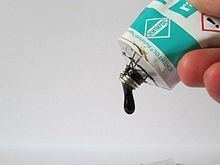Formula C28H36S5O6(NH4)2 | Soluble in Water | |
 | ||
Ammonium bituminosulfonate
Ammonium bituminosulfonate or ammonium bituminosulphonate (synonyms of ichthammol, CAS#8029-68-3 brand name: Ichthyol) is a product of natural origin obtained in the first step by dry distillation of sulfur-rich oil shale (bituminous schists). By sulfonation of the resulting oil (or purified fractions thereof) and subsequent neutralization with ammonia, Ichthammol results as viscous, water-soluble substance with characteristic bitumen-like odor. It is used in medicine as a treatment for different skin diseases, including eczema and psoriasis (see below). Ointments containing 10% or 20% Ichthammol are most common. They are sometimes called "black ointments" or "drawing salves". Ichthammol's dermatological action was promoted by German physician Paul Gerson Unna.
Contents
- Ammonium bituminosulfonate
- Composition
- Differentiation from Chinese Materials
- Human
- Veterinary
- References
Composition
From elemental analysis, its composition was calculated to be C28H36S5O6(NH4)2. However, as a product of natural origin, it is a mixture of many different compounds.
Chemically, it is a sulfonated shale oil that is incompatible with acids, alkali carbonates or hydrates and alkaloidal salts. It is a thick reddish brown liquid, possessing a bituminous odor and taste. It is soluble in water and miscible with glycerin, but is nearly insoluble in strong alcohol or concentrated ether. It contains a large percentage of organically combined sulfur.
Differentiation from Chinese Materials
Materials made in China (Pinyin transcription: yushizhi and yushizhi ruangao) and offered outside China as Ichthammol or Ammonium Bituminosulfonate are not in line with the definition given for this substance in the United States Pharmacopoeia (USP) or European Pharmacopoeia (Ph.Eur). Also, there is no conformity with the definition as connected to CAS# 8029-68-3. The Chinese material is derived from vegetable oils (e.g. soybean oil) instead of bituminous schists as required. As a result, its chemical basis is totally different from the one of Ichthammol USP/Ph.Eur./CAS# 8029-68-3. The characteristic bitumen-like odor (originating from the bituminous source material) is missing with Chinese material and thereby the original qualities according to common standards can be identified without doubt.
Human
Bituminosulfonates are classified as local therapeutic agents with very good tolerability. Pharmacologically, Ichthammol has anti-inflammatory, bactericidal, and fungicidal properties. It is used to treat eczema, psoriasis, Acne rosacea and acne, and it decreases microorganisms in the area surrounding a skin condition. It is commonly used in 10% or 20% concentrate ointment, applied topically.
In otology, a mixture of glycerol and ichthammol (G & I) is used for the topical treatment of ear infections. It is effective against Gram-positive organisms. The anti-inflammatory action is explained by its influence on the formation, secretion, and effect of inflammation mediators.
Ichthammol is recommended by dermatologists and available in pharmacies for compounding medications. Different sources of information exist for exemplary formulations (creams, shake lotions, suppositories, etc.). According to the "list of preferred Specials" by the British Association of Dermatologists (BAD) Ichthammol can be used in Dermatology prescribing to treat acutely inflamed atopic eczema, among others. A corresponding recommendation exists for bituminosulfonates in Germany. According to “guideline atopic eczema” bituminosulfonates can be considered for treatment of atopic eczema based on general clinic experience.
Veterinary
The European Medicines Agency published a summary report on ichthyol-substances (synonym: bituminosulfonates) during the course of the European Maximum Residue Limits (MRL) procedure in veterinary medicine. The Committee for Medicinal Products for Veterinary Use (CVMP) decided that due to good tolerance and safety, there is no need to establish an MRL for ichthyol-substances. As a result, ichthyol-substances can be applied topically in all mammalian food-producing species without restriction.
